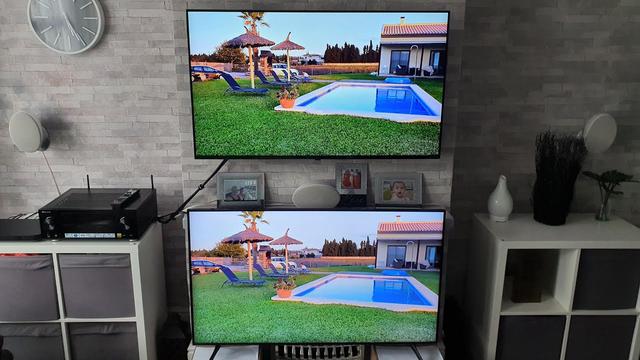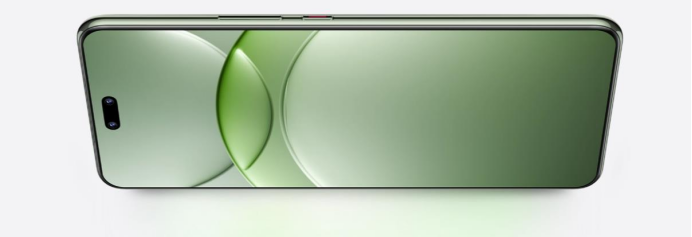LG and Samsung are, without doubt, two of the biggest names in the TV manufacturing game, providing the market with some of the best TVs for gaming and content consumption. Due to the competitive nature of the TV marketplace, we often get asked about the key differences between LG NanoCell vs Samsung QLED.
The two proprietary display technologies are fundamentally the same – both enhancing the qualities of LED panels. However, there are some slight differences that could make you think twice about your next TV purchase.
For that reason, we’ll be exploring all the major factors of both LG NanoCell and Samsung QLED to find out which you should buy.
What is LG Nanocell
NanoCell is a LG proprietary display technology used within its ‘NANO’ TVs to increase picture quality, color depth, and vividness of colors. To achieve this, LG uses a nanoscale filtering layer that sits in front of the LCD panel – helping to create more accurate red, green, and blue colors.
LG says that the tiny pixels are packed together tightly in order to remove any dull shades – resulting in brighter and more vivid colors with the same excellent viewing angles as before. They go on to say that LG NanoCell TVs only display ‘Pure colors’ with high consistency in wide viewing angles, making the overall viewing experience much greater than before.
You’ll be able to easily identify LG TVs with the NanoCell technology as they all use the ‘Nano’ naming structure. For example:
What is Samsung QLED
QLED stands for Quantum Dot LED and, like NanoCell, is a Samsung proprietary display technology. Despite fundamental differences, QLED and NanoCell work in a very similar manner – offering up common benefits.
Quantum dot technology utilizes nanocrystals to be able to define more accurate colors, better picture quality, and increased peak luminance. QLED displays color by allowing light to pass through its particle layer. With Samsung’s technology, the size of the dots is incredibly important as each size produces a unique color.
Samsung state that Quantum dots are ‘able to emit precise color light’ thanks to particle sizes adjusting at quantum-level velocities – resulting in much more accurate shades throughout its display.
Samsung QLED TVs still make use of an LCD panel at the rear, with a nanocrystal particle layer in front. Again, you can identify a QLED TV by the naming structure it utilizes. For example:
LG Nanocell Vs Samsung QLED: specifications
LG Nano85 TV
Sizes
49″, 55″, 65″
Resolution
4K UHD
Display Technology
NanoCell LED
Panel Type
IPS
Backlight
Edge LED
Refresh rate
100/120Hz
Processor
Alpha a7 Gen3
HDMI standard
HDMI 2.1
Number of HDMI ports
2 x HDMI 2.1, 2 x HDMI 2.0
VRR Technology
48-120Hz FreeSync
ProsGreater colors
More accurate than traditional LED-LCD panels
High peak luminance
ConsLacks OLED HDR performance and contrast ratio
Shop on Amazon
CHECK PRICESamsung Q70T QLED TV
Sizes
55″, 65″, 75″, 85″
Resolution
4K UHD
Display Technology
Samsung QLED
Panel Type
VA
Backlight
Edge LED
Refresh rate
100/120Hz
Processor
Quantum Processor 4K
HDMI standard
HDMI 2.1
Number of HDMI ports
4 (1 x HDMI 2.1)
VRR Technology
48-120Hz FreeSync & G-Sync
ProsGreat colors
More vivid tones
Excellent viewing angles
ConsLacks OLED color accuracy and contrast ratio
Shop on Amazon
CHECK PRICEAbove is a side-by-side comparison chart that displays the main features and specifications of an LG NanoCell TV vs a Samsung QLED.
On paper, there really aren’t that many primary specification differences when comparing the Samsung QLED and LG NanoCell technologies. That being said, however, they aren’t identical.
Taking a closer look at the specs, you can see that the two TV types differ when it comes to panel type – and that’s pretty huge when it comes to the performance of the panel.
What is the panel type?
Every TV or monitor comes equipped with a specific panel type that dictates many of its features and performance traits. There are three main types of panel type in todays market; VA (Vertical alignment), TN (Twisted nematic), and IPS (in-plane switch).
See the complete TN vs IPS vs VA guide here.
In the above scenario, LG has opted for the IPS panel while Samsung utilizes the VA – but why?
Like most technologies, the panel type you choose can affect everything from price to performance. This actually allows manufacturers to better tailor a TV to its target market by choosing a panel type that excels in certain situations.
See table below for an better look at the differences between panel type:
As you can see from the table above, each of the three panel types offers its own set of features and benefits.
IPS vs VA
In the LG NanoCell vs Samsung QLED debate, it comes down to VA vs IPS – the two panel types that excel in content consumption scenarios.
LG have chosen the IPS panel type for its NanoCell TVs as it provides the best viewing angles, greatest color accuracy, and more vibrancy throughout. That said, IPS panels do have their flaws. Peak brightness has always been a problem with IPS panels and is one of the main benefits of utilizing NanoCell technology.
Samsung has decided to utilize VA panels for its QLED series, offering up much greater contrast ratio, deeper blacks, greater peak luminance, and more advanced HDR performance. All good stuff. Again though, VA isn’t perfect – displaying annoying screen artifacts like blooming and backlight bleed. Furthermore, viewing angles and color accuracy simply isn’t as good as the IPS alternative.
Does panel type affect responsiveness?
One of the big questions we get asked when it comes to the NanoCell Vs QLED debate is, which is more responsive? It’s a good questions when purchasing a modern TV as many feature HDMI 2.1 support, up to 120Hz refresh rate, and VRR technology for FreeSync and G-Sync systems.
That being said, when comparing VA to IPS, there isn’t a huge difference when it comes to general pixel response and refresh times. As you can see from the specifications above, both feature support for 120Hz refresh rates – making them a great choice for console gamers who want to reap the rewards of 4K gameplay at high refresh rates.
Is there a different in size?
As you’d expect, both NanoCell and QLED come in a variety of sizes. Of course, different models feature different sizes, so be aware that not all QLED or NanoCell TVs will feature a size you require.
As a general rule, most TVs can be found between 48″ and 97″ (unless you want one of the latest 42″ LG OLED TVs) – with both LG and Samsung offering these sizes.
LG NanoCell Vs Samsung QLED: Which should you buy?
So, which TV should you buy? Well, it all comes down to what you prioritize in your visual experience. Like we said, both TVs come to shelves boasting a unique set of pros and cons – it all depends on which pros suit your needs the most.

For me, the LG NanoCell TV takes the prize – but not by much. I prioritize rich, deep, immersive colors that are true to what the creator envisaged – and that’s exactly what you get with LG’s NanoCell. Thanks to the utilization of IPS panel technology, the NanoCell provides stunning color accuracy that is enhanced by LG’s nanoparticle layer for a truly breathtaking experience.
Furthermore, NanoCell TVs also provide incredibly good viewing angles – something the QLED alternative simply can’t live up to. No matter where you plan on viewing the TV from, you’ll be experiencing excellent color reproduction.
On the flip side, QLED TVs feature a much more realistic HDR experience which is very high on many people’s list of priorities. Thanks to the much wider contrast ratio that comes with a VA panel (around 2500:1), blacks seem much deeper and luminance is far brighter. Not only does this increase the general picture quality of your TV but it’ll also help create immersion when watching movies and TV shows.
Ultimately, whether you choose an LG NanoCell TV or an Samsung QLED TV, you’ll be getting a very reputable TV that delivers a superb visual experience. It all comes down to a few simple features that revolve around color accuracy, viewing angles, and contrast ratio.




